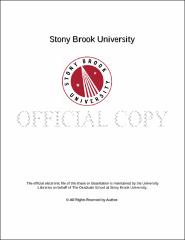| dc.identifier.uri | http://hdl.handle.net/11401/77064 | |
| dc.description.sponsorship | This work is sponsored by the Stony Brook University Graduate School in compliance with the requirements for completion of degree. | en_US |
| dc.format | Monograph | |
| dc.format.medium | Electronic Resource | en_US |
| dc.language.iso | en_US | |
| dc.publisher | The Graduate School, Stony Brook University: Stony Brook, NY. | |
| dc.type | Dissertation | |
| dcterms.abstract | Copper-based heterogeneous catalysts are widely used in many industrial applications across the fields of fuels and energy. In order to probe the catalyst structure under reaction conditions, state-of-the-art ambient pressure techniques have been implemented. This dissertation is focused on room temperature in situ ambient pressure (AP) (10 mTorr to 2 Torr) studies on Cu-based model catalysts including Cu(111), Cu2O/Cu(111), potassium modified Cu2O/Cu(111) and CeO2/Cu2O/Cu(111). It investigates their surface dynamic transformations using scanning tunneling microscopy (STM), infrared reflection adsorption spectroscopy (IRRAS), and X-ray photoelectron spectroscopy (XPS). Under ambient pressures, Cu(111) surface is roughened by CO, or O2. Atomic H can heal nano-pits formed on the surface of Cu(111). Both CO and H2 reduce Cu2O/Cu(111), but the reduction occurs ~100 times slower in the latter case. As reduction proceeds, phases of Cu2O/Cu(111), the intermediate Cu2O-hex/5-7 structure, and Cu segregate, and the Cu metallic front forms by mass transfer. When reduced by CO, the potassium modified Cu2O/Cu(111) catalyst system has a rate orders of magnitude higher than the unmodified surface, due to the formation of active sites at the location of the potassium species. However, this modification does not promote the reduction by H2. Low coverages of CeO2 supported on Cu2O/Cu(111) were prepared, and it is shown that Ce4+ is reduced to Ce3+ prior to Cu2O reduction by 1.5 Torr H2. The hydrogenation of ceria results in an expanded Ce-O-Cu interface, which facilitates methanol synthesis from CO2. CO oxidation by O2 occurs on Cu(111) at 300 K. The top layer of Cu(111) is oxidized to Cu+ and Cu2+ under a mixture of 30 mTorr CO and 15 mTorr O2. Even under a similar total pressure with an 8:1 CO:O2 ratio, copper oxidation cannot be avoided. Reactants are consumed through redox cycles, and the surface eventually reaches a dynamic equilibrium. The activity trend of the Cu species at the surface for producing CO2 is Cu > Cu+ >> Cu2+. | |
| dcterms.available | 2017-09-20T16:51:50Z | |
| dcterms.contributor | White, Michael G | en_US |
| dcterms.contributor | Stacchiola, Dario J | en_US |
| dcterms.contributor | Hanson, David M | en_US |
| dcterms.contributor | Boscoboinik, Jorge A. | en_US |
| dcterms.creator | Xu, Fang | |
| dcterms.dateAccepted | 2017-09-20T16:51:50Z | |
| dcterms.dateSubmitted | 2017-09-20T16:51:50Z | |
| dcterms.description | Department of Chemistry | en_US |
| dcterms.extent | 148 pg. | en_US |
| dcterms.format | Monograph | |
| dcterms.format | Application/PDF | en_US |
| dcterms.identifier | http://hdl.handle.net/11401/77064 | |
| dcterms.issued | 2016-12-01 | |
| dcterms.language | en_US | |
| dcterms.provenance | Made available in DSpace on 2017-09-20T16:51:50Z (GMT). No. of bitstreams: 1
Xu_grad.sunysb_0771E_12731.pdf: 10777005 bytes, checksum: 2128d542d241b3599dc6f9d778cdaa91 (MD5)
Previous issue date: 1 | en |
| dcterms.publisher | The Graduate School, Stony Brook University: Stony Brook, NY. | |
| dcterms.subject | Chemistry -- Physical chemistry | |
| dcterms.title | In situ Ambient Pressure Studies of Dynamic Surface Transformations on Cu-based Model Catalysts | |
| dcterms.type | Dissertation | |

